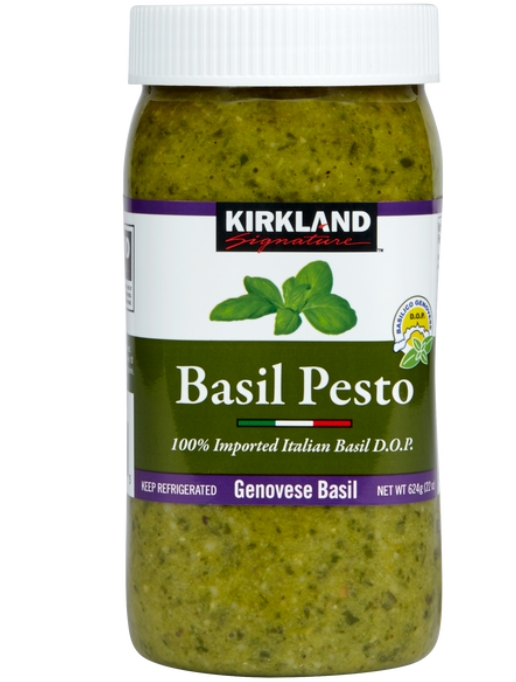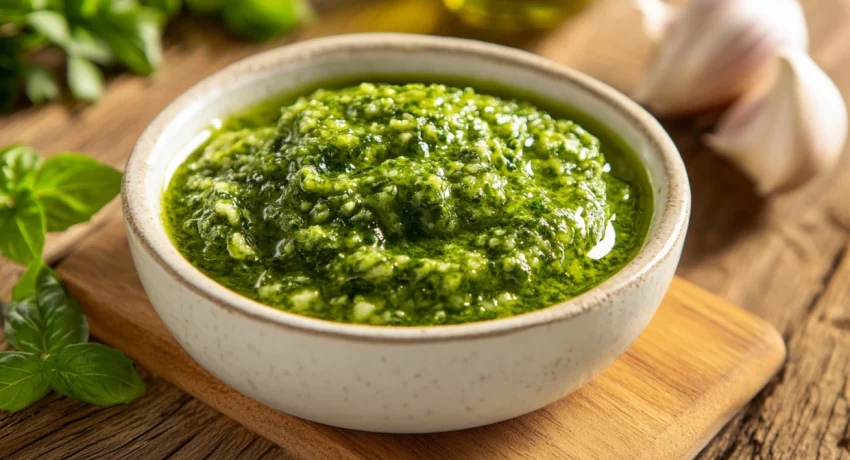
Kirkland Signature Imported Basil Pesto, 22 oz
- Imported Basil Pesto
- Genovese basil
- 22 oz jar
From Italian Tradition to Warehouse Sensation: The Complete Guide to Costco’s Beloved Basil Blend
In the vast landscape of supermarket offerings, few products inspire the same level of devoted enthusiasm as Kirkland Signature Pesto. This humble jar of vibrant green goodness has become something of a culinary phenomenon among Costco members, earning its place as a pantry staple in countless households. As someone who has experimented with virtually every pesto variety available on market shelves, I can confidently say that Kirkland’s Pesto offers an unmatched combination of authentic flavor, quality ingredients, and remarkable value that makes it worthy of the dedicated following it has amassed.
But what exactly makes this particular pesto so special? Is it the fresh basil? The perfect balance of cheeses? The high-quality olive oil? Or perhaps it’s the convenience factor combined with Costco’s famously reasonable pricing? Today, we’re diving deep into the world of Kirkland Pesto to uncover everything you need to know about this beloved condiment that has transformed weeknight dinners across America.
The Authentic Ingredients Behind Kirkland’s Signature Pesto
The foundation of any great pesto begins with its ingredients, and Kirkland doesn’t cut corners. Opening a jar reveals a vibrant green mixture that immediately releases the distinctive aroma of fresh basil. Unlike many commercial pestos that rely heavily on fillers or preservatives, Kirkland’s version stays remarkably true to traditional Genovese pesto recipes.
The ingredient list reads like something you’d expect from a high-end Italian delicatessen: fresh basil leaves (and plenty of them), extra virgin olive oil, pine nuts, Parmesan cheese, pecorino Romano cheese, garlic, salt, and a touch of citric acid to maintain freshness. What’s notably absent are unnecessary additives, artificial flavors, or colorings that plague many mass-produced alternatives.
The basil question is one that frequently arises among pesto enthusiasts. While some jarred pestos use dried basil or basil paste, Kirkland uses genuine fresh basil as its primary ingredient. This commitment to quality is immediately evident in both the vibrant color and robust flavor profile. The basil is harvested at peak freshness, processed quickly, and preserved in the traditional method to maintain its aromatic qualities.
Another distinguishing factor is Kirkland’s use of both Parmesan and pecorino Romano cheeses. This dual-cheese approach creates a more complex flavor profile than pestos that rely solely on Parmesan. The sharp, slightly salty character of the pecorino complements the nutty, umami-rich Parmesan perfectly, creating a depth of flavor that elevates any dish it touches.
Value Proposition: Price Point and Portion Size
One of the most compelling aspects of Kirkland Pesto is its remarkable value. Currently priced at approximately $10.99 for a generous 22-ounce jar (prices may vary slightly by location), it represents one of the best values in the pesto market. When you break it down by ounce, you’re paying roughly 50 cents per ounce—a fraction of what you’d pay for smaller gourmet pesto jars that often retail for $6-8 for just 6-8 ounces.
The serving size listed on the jar is 1/4 cup (approximately 2 ounces), which is generous enough to coat pasta for 2-3 people. This means a single jar can provide the foundation for about 10-11 meals, making it not just delicious but economical for regular use. For families or frequent entertainers, this value proposition becomes even more attractive.
This cost-effectiveness doesn’t come at the expense of quality either. When compared side-by-side with premium pestos costing two or three times as much per ounce, Kirkland’s version holds its own remarkably well, and in many blind taste tests, it actually outperforms its more expensive competitors.
Nutritional Profile: What’s in Your Spoonful?
Understanding the nutritional content of Kirkland Pesto helps explain both its rich flavor and how it might fit into various dietary approaches. Per 1/4 cup serving (approximately 2 ounces), Kirkland Pesto contains:
- Calories: Approximately 240-250 calories
- Fat: 24-25g (primarily from olive oil and pine nuts)
- Saturated Fat: 4-5g
- Carbohydrates: 3-4g
- Protein: 5-6g
- Sodium: 560-580mg
This nutritional profile makes Kirkland Pesto a relatively high-calorie condiment, but those calories come primarily from nutrient-dense sources like olive oil and pine nuts, which provide healthy monounsaturated fats. The moderate protein content comes from the cheese components, while the carbohydrate count remains quite low.
For those following specific dietary protocols, it’s worth noting that Kirkland Pesto is naturally gluten-free, making it suitable for those with celiac disease or gluten sensitivities. However, it does contain dairy (from the Parmesan and pecorino Romano) and nuts (pine nuts), so it’s not appropriate for those with these specific allergies or dietary restrictions.
For keto dieters, the low carbohydrate count (3-4g per serving) makes Kirkland Pesto an excellent addition to a ketogenic meal plan. The high fat content aligns perfectly with keto macronutrient requirements, and the minimal carbs won’t disrupt ketosis when used in reasonable amounts.
Unfortunately for vegans, the traditional recipe including cheese means Kirkland Pesto is not vegan-friendly. Those seeking a plant-based alternative would need to look elsewhere or create a homemade vegan version.
The Olive Oil Advantage
One of the defining characteristics that separates premium pesto from mediocre alternatives is the quality of olive oil used. Kirkland doesn’t disappoint here, utilizing genuine extra virgin olive oil as a primary ingredient. This choice contributes significantly to both the flavor profile and the nutritional benefits.
Extra virgin olive oil provides the distinctive fruity, slightly peppery base notes that complement the herbal qualities of the basil. It also contributes healthy monounsaturated fats and antioxidant compounds that have been associated with numerous health benefits, from cardiovascular support to anti-inflammatory properties.
Many lower-quality pestos substitute less expensive oils like sunflower or canola, or use lower grades of olive oil to reduce costs. These substitutions noticeably impact the flavor, creating a flatter, less complex taste experience. The commitment to quality olive oil is one more way that Kirkland demonstrates its dedication to authenticity.
Competitive Landscape: How Does Kirkland Compare?
When placed alongside other commercially available pestos, Kirkland consistently performs impressively in both formal and informal taste comparisons. Its most direct competitors include:
- Barilla Pesto Genovese: Generally pricier per ounce with a similar flavor profile but often with a slightly more processed texture.
- Classico Traditional Basil Pesto: More widely available in standard grocery stores but typically contains more additives and a less pronounced fresh basil flavor.
- Rana Basil Pesto: A premium competitor with excellent quality but at nearly double the price per ounce.
- Trader Joe’s Pesto alla Genovese: Similarly priced but in much smaller jars, with a slightly less complex flavor profile.
What distinguishes Kirkland in these comparisons is its balance of authenticity, freshness, and value. While some competitors may excel in one particular area—perhaps a slightly more rustic texture or a more aggressive garlic note—none seem to hit the sweet spot of quality and value quite like Kirkland’s offering.
In blind taste tests, Kirkland typically ranks among the top three choices, often beating out products costing significantly more. The consistency of quality across jars is another strength; while some brands suffer from batch variation, Kirkland maintains reliable standards from jar to jar.
Culinary Applications: Beyond Basic Pasta
While tossing pesto with pasta might be the most familiar application, Kirkland Pesto’s versatility extends far beyond this classic preparation. Its robust flavor profile and convenient ready-to-use format make it an excellent ingredient for creative culinary explorations.
Pasta Perfection
Starting with the classic, Kirkland Pesto elevates any pasta dish with minimal effort. For a traditional preparation, simply toss with al dente pasta, adding a splash of the pasta cooking water to help the sauce adhere to the noodles. Long shapes like linguine or fettuccine work beautifully, as do shorter forms like fusilli or farfalle that capture the sauce in their crevices.
For a more substantial meal, add grilled chicken, sautéed shrimp, or roasted vegetables. A sprinkle of extra Parmesan and a few toasted pine nuts complete the presentation. For a creamier variation, blend the pesto with a touch of heavy cream or ricotta for a luxurious sauce that clings beautifully to the pasta.
Sandwich and Wrap Enhancer
Forget mayo or mustard—Kirkland Pesto transforms ordinary sandwiches into gourmet creations. Spread it on crusty bread before adding turkey, mozzarella, and roasted red peppers for an Italian-inspired lunch. It pairs particularly well with grilled chicken, fresh tomatoes, and arugula in wraps or paninis.
For a vegetarian option, layer pesto with fresh mozzarella, sliced tomatoes, and basil leaves for a caprese sandwich that showcases the Mediterranean flavors. Even a humble grilled cheese becomes extraordinary when brushed with a thin layer of pesto before grilling.
Pizza Base and Flatbreads
Traditional tomato sauce isn’t the only option for pizza. Kirkland Pesto makes an exceptional base for white pizzas and flatbreads. Spread a thin layer over pizza dough, then top with mozzarella, fontina, or goat cheese and add toppings like artichoke hearts, grilled chicken, or sundried tomatoes.
For quick appetizers, spread pesto on naan bread or flatbread, add a sprinkle of cheese, and broil until bubbling. Finish with fresh arugula and a drizzle of balsamic glaze for a sophisticated starter that comes together in minutes.
Protein Enhancer
Kirkland Pesto works wonders as a marinade or finishing sauce for proteins. Brush it over chicken breasts before baking or grilling for instant flavor. Mix a spoonful into turkey meatballs or burgers before cooking to infuse them with herbs and cheese.
For seafood, add a dollop to grilled salmon or mix with butter to create a compound butter that melts beautifully over seared scallops or shrimp. Even tofu benefits from pesto’s robust flavors—marinate firm tofu in pesto before pan-frying for a vegetarian main with Italian flair.
Grain Bowls and Salads
Transform everyday grain bowls by stirring pesto into warm quinoa, farro, or rice. The heat helps the flavors bloom throughout the grain, creating a flavorful base for adding roasted vegetables, proteins, and fresh greens.
For salads, thin the pesto slightly with additional olive oil and a touch of lemon juice to create a vibrant dressing. It pairs beautifully with Mediterranean-inspired salads featuring cucumbers, tomatoes, olives, and feta, or with grain salads incorporating roasted vegetables and chickpeas.
Soup Enhancer
A final flourish of pesto adds dimension to soups, especially those with complementary flavors. A spoonful swirled into minestrone, white bean soup, or even a simple tomato soup elevates the entire dish. For a distinctive appetizer, float a small dollop atop creamy soups like potato or cauliflower just before serving.
Storage Considerations: Maximizing Shelf Life
Once you’ve invested in Kirkland Pesto, proper storage becomes essential to maintain its quality. The unopened jar has a shelf life of 12-18 months when stored in a cool, dark pantry. However, once opened, refrigeration becomes mandatory to preserve freshness and prevent spoilage.
In the refrigerator, an opened jar typically maintains peak quality for 7-10 days. To extend this period, always use clean utensils when scooping from the jar to prevent introducing bacteria. Additionally, a thin layer of olive oil poured over the surface before resealing creates a protective barrier against oxidation, which can cause discoloration and flavor degradation.
For those who can’t use a full jar within this timeframe, freezing offers an excellent solution. Kirkland Pesto freezes remarkably well, with minimal impact on flavor or texture upon thawing. The most practical method is to portion the pesto into ice cube trays (approximately 1-2 tablespoons per cube), freeze until solid, then transfer the frozen cubes to a ziplock bag for longer storage. These individual portions thaw quickly and allow you to use just what you need for a particular recipe.
Frozen pesto maintains good quality for up to 6 months, making it possible to stock up during Costco trips without worrying about waste. When ready to use, simply thaw the desired amount in the refrigerator overnight or at room temperature for about an hour. For hot applications like pasta, you can even add the frozen cube directly to the hot pasta and stir until melted.
The Italian Connection: Made in Italy?
Many pesto enthusiasts wonder about the origins of Kirkland Pesto, particularly whether it’s made in Italy as authentic pesto originated in Genoa. Kirkland Signature Pesto is indeed produced in Italy, specifically in the Liguria region where traditional Genovese pesto originated centuries ago.
This Italian production contributes significantly to its authentic character. The basil grown in this Mediterranean climate has distinctive aromatic qualities that are difficult to replicate elsewhere. Similarly, the cheese components—Parmesan and pecorino Romano—benefit from traditional Italian production methods that have been refined over generations.
Costco’s partnership with Italian producers allows them to maintain traditional methods while achieving the scale necessary for their worldwide distribution. This connection to the culinary heritage of pesto’s birthplace is evident in the final product’s balanced flavor profile and authentic character.
Consumer Verdict: What Do Reviews Say?
The court of public opinion has rendered its verdict on Kirkland Pesto, and it’s overwhelmingly positive. Across various review platforms, cooking forums, and social media groups, Kirkland Pesto consistently earns 4.5-5 star ratings from consumers.
Many reviewers specifically highlight the authentic flavor profile, noting that it tastes homemade rather than mass-produced. The fresh basil flavor receives particular praise, as does the balanced garlic presence—pronounced enough to be distinctive without overwhelming the other ingredients.
Value is another consistently mentioned strength. Numerous reviewers compare it favorably to restaurant-quality pesto while noting the significant cost savings compared to both dining out and purchasing smaller premium jars from specialty stores.
The main criticisms, though relatively rare, tend to focus on the sodium content (which is typical for cheese-based products) and the relatively short refrigerator life after opening. Some also mention that the texture is slightly smoother than traditional hand-pounded pesto, though most find this difference minimal and acceptable given the convenience factor.
Perhaps most tellingly, Kirkland Pesto has developed something of a cult following, with dedicated fans stocking up during Costco runs and even gifting jars to friends and family who don’t have Costco memberships. This level of consumer loyalty is rare in the packaged food world and speaks to the product’s consistent quality and broad appeal.
Purchasing Options: Where to Find Kirkland Pesto
As a Kirkland Signature product, this pesto is primarily available at Costco warehouse locations worldwide. It’s typically found in the refrigerated section near other prepared foods and dips, rather than with shelf-stable pasta sauces.
For those without convenient access to a physical Costco location, limited online options exist. Costco.com sometimes offers the pesto for delivery, though availability varies by region and it may require a Costco membership to purchase. Occasionally, it appears on third-party delivery services that partner with Costco, though prices may be higher than in-store.
Some enterprising individuals have also taken to reselling Kirkland products on platforms like Amazon and eBay, though these options typically come with significant markups and may have shortened expiration dates. For the best value and freshness, purchasing directly from Costco remains the optimal choice.
The Final Verdict: Why Kirkland Pesto Deserves a Place in Your Kitchen
After examining Kirkland Pesto from every angle—ingredients, nutrition, versatility, value, and consumer reception—it’s clear why this product has developed such a devoted following. Few food products manage to balance quality, authenticity, and affordability so successfully.
For busy home cooks, it offers a convenient shortcut that doesn’t sacrifice flavor or quality. For culinary enthusiasts, it provides a versatile ingredient that can elevate countless dishes with minimal effort. For budget-conscious shoppers, it delivers exceptional value compared to premium alternatives.
The secret to Kirkland Pesto’s success lies in its unwavering commitment to quality ingredients and traditional methods, scaled up for mass production without compromising the essence of what makes pesto special. This balance is remarkably difficult to achieve, and many other commercial products fall short in their attempts.
Whether you’re tossing it with pasta for a quick weeknight dinner, spreading it on sandwiches for an elevated lunch, or incorporating it into more complex recipes, Kirkland Pesto delivers consistent, authentic flavor that has rightfully earned its place as a pantry (or refrigerator) staple in homes across America.
In a world of mass-produced food products that often prioritize shelf stability and cost-cutting over flavor, Kirkland Pesto stands as a refreshing exception—proof that scale and quality can coexist when a company commits to doing things right. For pesto lovers, it’s not just a convenient option; it’s become the standard against which other commercial pestos are measured, and few can match its perfect balance of tradition, quality, and value.




